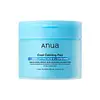What's inside
What's inside
 Key Ingredients
Key Ingredients

 Benefits
Benefits

 Concerns
Concerns

 Ingredients Side-by-side
Ingredients Side-by-side

Water
Skin ConditioningPropanediol
SolventMethylpropanediol
SolventGlycereth-26
Humectant1,2-Hexanediol
Skin ConditioningTrehalose
HumectantHydroxyacetophenone
AntioxidantDiethoxyethyl Succinate
SolventNiacinamide
SmoothingButylene Glycol
HumectantHydroxyethyl Urea
HumectantSodium Citrate
BufferingGlycerin
HumectantCoptis Japonica Root Extract
Skin ConditioningCitric Acid
BufferingDisodium EDTA
Methyl Diisopropyl Propionamide
MaskingCamellia Sinensis Catechins
AntioxidantXanthan Gum
EmulsifyingPanthenol
Skin ConditioningCaffeine
Skin ConditioningDextrin
AbsorbentTheobroma Cacao Seed Extract
AntioxidantHydrolyzed Sodium Hyaluronate
Skin ConditioningViola Mandshurica Flower Extract
AntioxidantDiospyros Kaki Leaf Extract
Skin ProtectingDioscorea Japonica Root Extract
Skin ConditioningLaminaria Japonica Extract
Skin ProtectingAloe Barbadensis Leaf Extract
EmollientVitis Vinifera Fruit Extract
Skin ConditioningUlmus Davidiana Root Extract
Skin ConditioningEthylhexylglycerin
Skin ConditioningCarthamus Tinctorius Flower Extract
Skin ConditioningPolygonum Cuspidatum Root Extract
AntioxidantCoffea Arabica Seed Extract
MaskingZanthoxylum Piperitum Fruit Extract
Skin ConditioningCastanea Crenata Shell Extract
Skin ConditioningCamellia Sinensis Leaf Extract
AntimicrobialAscorbic Acid
AntioxidantSodium Hyaluronate
HumectantCentella Asiatica Extract
CleansingTannic Acid
AstringentHydroxypropyltrimonium Hyaluronate
Zinc Oxide
Cosmetic ColorantSodium Acetylated Hyaluronate
HumectantHydrolyzed Hyaluronic Acid
HumectantSaponins
CleansingTriethoxycaprylylsilane
Hyaluronic Acid
HumectantMineral Salts
Skin ConditioningSodium Hyaluronate Crosspolymer
HumectantPotassium Hyaluronate
Skin ConditioningWater, Propanediol, Methylpropanediol, Glycereth-26, 1,2-Hexanediol, Trehalose, Hydroxyacetophenone, Diethoxyethyl Succinate, Niacinamide, Butylene Glycol, Hydroxyethyl Urea, Sodium Citrate, Glycerin, Coptis Japonica Root Extract, Citric Acid, Disodium EDTA, Methyl Diisopropyl Propionamide, Camellia Sinensis Catechins, Xanthan Gum, Panthenol, Caffeine, Dextrin, Theobroma Cacao Seed Extract, Hydrolyzed Sodium Hyaluronate, Viola Mandshurica Flower Extract, Diospyros Kaki Leaf Extract, Dioscorea Japonica Root Extract, Laminaria Japonica Extract, Aloe Barbadensis Leaf Extract, Vitis Vinifera Fruit Extract, Ulmus Davidiana Root Extract, Ethylhexylglycerin, Carthamus Tinctorius Flower Extract, Polygonum Cuspidatum Root Extract, Coffea Arabica Seed Extract, Zanthoxylum Piperitum Fruit Extract, Castanea Crenata Shell Extract, Camellia Sinensis Leaf Extract, Ascorbic Acid, Sodium Hyaluronate, Centella Asiatica Extract, Tannic Acid, Hydroxypropyltrimonium Hyaluronate, Zinc Oxide, Sodium Acetylated Hyaluronate, Hydrolyzed Hyaluronic Acid, Saponins, Triethoxycaprylylsilane, Hyaluronic Acid, Mineral Salts, Sodium Hyaluronate Crosspolymer, Potassium Hyaluronate
 Reviews
Reviews

Ingredients Explained
These ingredients are found in both products.
Ingredients higher up in an ingredient list are typically present in a larger amount.
Butylene Glycol (or BG) is used within cosmetic products for a few different reasons:
Overall, Butylene Glycol is a safe and well-rounded ingredient that works well with other ingredients.
Though this ingredient works well with most skin types, some people with sensitive skin may experience a reaction such as allergic rashes, closed comedones, or itchiness.
Learn more about Butylene GlycolCamellia Sinensis Leaf Extract is derived from the leaves of the tea plant. Black tea, green tea, and oolong tea are all harvested from this plant.
This ingredient has many skin benefits:
This ingredient contains polyphenols, a strong antioxidant. Antioxidants help fight off molecules that damage skin cells.
On top of that, the antioxidants in green tea neutralize free-radicals from the sun. This gives the skin some extra UV protection, but should not replace sunscreen.
Many components of tea have anti-inflammatory properties.
Polyphenols and L-theanine help soothe the skin and reduce irritation. The caffeine in Camellia Sinensis Leaf Extract helps calm inflamed blood vessels.
Other compounds found in tea include: Vitamin Bs, linoleic acid, magnesium, calcium, iron, and zinc.
Research has shown both drinking Camellia Sinensis Leaf Tea and applying it to the skin can help boost skin elasticity and hydration. Studies also show using tea extract may reduce sebum, or oil, production.
Learn more about Camellia Sinensis Leaf ExtractGlycerin is already naturally found in your skin. It helps moisturize and protect your skin.
A study from 2016 found glycerin to be more effective as a humectant than AHAs and hyaluronic acid.
As a humectant, it helps the skin stay hydrated by pulling moisture to your skin. The low molecular weight of glycerin allows it to pull moisture into the deeper layers of your skin.
Hydrated skin improves your skin barrier; Your skin barrier helps protect against irritants and bacteria.
Glycerin has also been found to have antimicrobial and antiviral properties. Due to these properties, glycerin is often used in wound and burn treatments.
In cosmetics, glycerin is usually derived from plants such as soybean or palm. However, it can also be sourced from animals, such as tallow or animal fat.
This ingredient is organic, colorless, odorless, and non-toxic.
Glycerin is the name for this ingredient in American English. British English uses Glycerol/Glycerine.
Learn more about GlycerinWater. It's the most common cosmetic ingredient of all. You'll usually see it at the top of ingredient lists, meaning that it makes up the largest part of the product.
So why is it so popular? Water most often acts as a solvent - this means that it helps dissolve other ingredients into the formulation.
You'll also recognize water as that liquid we all need to stay alive. If you see this, drink a glass of water. Stay hydrated!
Learn more about Water